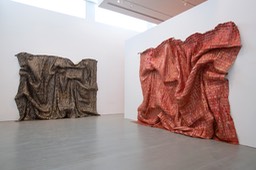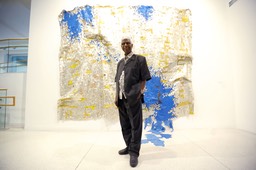El Anatsui’s Miami Beach exhibition at Bass merges colonial past with contemporary art
BY GEORGE FISHMAN
SPECIAL TO THE MIAMI HERALD
06/07/14
Audio
Hear José Diaz on installing the work: bitly.com/JoseDiazInstallation
Hear Adrienne von Lates on Garden Wall: bitly.com/AdrienneVonLatesSublime
Gravity and Grace is an apt title for this retrospective of internationally celebrated artist El Anatsui. But look for playful notes as well. The Bass Museum, Miami-Dade County’s oldest municipal exhibition space, is celebrating its 50th year, and this dazzling show provides a fitting complement to current and planned presentations.
Anatsui’s voluptuous, fluid, metal wall sculptures dominate the show. These breakthrough works have catapulted the artist into global acclaim during the past decade. Combining the homey appeal of vibrant patchwork quilts with the sophisticated color blending of tessellated mosaics and digital pixelation, his category-crossing works dramatically swoop and drape from wall to floor and convey the majesty of natural phenomena.
In Africa, where resources are often scarce, milk cartons, soft drink cans and other found objects are used to make toys and household goods. Anatsui uses them not out of necessity, but as a reference to the history of colonialism, which the artist, born in Ghana, knows well.
Bass curator of exhibitions José Carlos Diaz provided a comprehensive tour that began on the ground level with an array of floor-mounted sculptures called Peak, which resemble miniature mountain ranges . He explained that these were fabricated from the lids of shiny/rusty milk cans.
“Peak” also is a brand of canned milk that is ubiquitous in Ghana and in Nigeria, where Anatsui has lived since 1975. The lids are a residue of the historically lopsided trade between Europe and Africa. As it says on the Dutch company’s website, “For millions of Nigerians, Peak is milk and milk is Peak.”
Since the late ’90s, the artist has taken thousands of such tin can lids and liquor bottle caps, directing a crew of studio assistants to cut, pierce, fold and wire them into distinctive forms and compositions.
On a nearby wall, Ink Splash, the smallest work in the show, spills onto the floor, representing the intersection of painting and sculpture. “It looks a lot like a mosaic, but then you start noticing the ruffles and folds. The piece is very much in movement,” Diaz says. “It’s not static and it wants to either touch the ground or creep elsewhere.”
SLAVE TRADE
The liquor bottle caps bear a grim association with the slave trade route connecting Europe, Africa and the Americas. Anatsui’s work is not overtly political, but the back story remains potent.
Ellen Rudolph, the former senior curator of the Akron Art Museum, first conceived and organized the show there. Bass Director Silvia Karman Cubiña recognized an inspired fit for South Florida’s multifarious audiences. It will complete its five-stop tour in San Diego.
The tour continues along the ramp that connects the Bass’ first and second floors, providing unique viewing positions. Peak, when seen from above, flows caterpillar-like. Mask of Humankind transforms from pixelated patchiness into a blended color field “painting” when viewed from near and far.
Diaz says, “As you approach them you can see that each bottle cap has a combination of colors — whether it’s from the graphic logos, whether it’s because they’re paired together with similar other bottle caps, whether the bottle cap is in reverse, so you’re seeing the metal and not the actual color of the logo or the graphic.”
The eight segments of Drifting Continents evoke the varied character of topographies — and of people. They nudge one another along the wall flanking the ramp.
“Just the way they are unique in their presentation, they are unique in their construction. They’re asymmetrical, and there are no 90-degree angles.”
As we approach the top of the ramp, Diaz points out that Ozone Layer’s “fabric” has been opened up, and individual squares gently flap in the breezes provided by an array of semi-hidden fans.
The next gallery is devoted to Wall. This five-part installation explores how mankind creates barriers. But by using only the bottle cap rings, Anatsui created a lacy translucency through which visitors are revealed and obscured.
“Although we’re physically prevented from traveling through them, we can visually experience the whole room without the barriers blocking our vision,” Diaz remarks as we pass among the diaphanous veils.
Fabrication and installation are both labor-intensive. “In his studio in Nigeria, individuals pound and weave together small sheets of these bottle caps. They’re placed on the floor, and El Anatsui, in an abstract way, pieces together colors and textures to find a final resolution … and with the studio assistants he is able to play with texture and color and when he’s satisfied, able to combine them,” Diaz says.
Even the seemingly monochromatic Red Block and Black Block — both as elegant as evening gowns — reveal nuances of pointillist color blending when closely examined in their second-floor gallery.
INSTALLATION
Like enormous rugs, the crated metal works arrive stacked or rolled. Although the artist gives considerable latitude to each venue for installation, the Akron Art Museum sends their experienced preparator for guidance. The jagged and malleable pieces are beautiful to look at but hazardous to manipulate.
“We’ve used two scissors lifts,” Diaz says. “We have to take the whole work rolled up, and essentially drop it down. As it cascades down we’ll start to place hooks, lift portions of the work so it can start taking some of the weight and essentially creating all these grooves and curves and folds.”
“There is an excitement to see what one hook, one screw can do to transform the whole piece.” Then, during final days, the artist made a variety of “tweaks.”
The tour next takes a look back. “The orange room we are entering is the very middle of the exhibition,” says Diaz. “It features the wooden works that El Anatsui has made since the mid-’80s. What’s interesting to note is that the room also includes preliminary sketches for these.”
Anatsui doesn’t sketch his metal pieces, but the wooden sculptures and drawings prefigure these later works in several ways.
“You’ll see the appearance of colors. You’ll see the appearance of motifs that look like gathered circles — cut circles, which would become bottle caps,” Diaz explains. “The works also have early elements of the use of copper wire. You’ll see copper wire that’s coiled around the wooden posts.”
There are anthropomorphic and totem-like qualities in these pieces, which reveal the artist’s deep grounding in African visual and social history. Also, lively patterning. Comparison to African kente cloth and to European tapestry is inevitable but limiting. Although surrounded by weavers during his childhood, the artist had no affinity for fabrics during his student years. And he has expressed regret that some viewers look no deeper than this facile association with textiles when assessing his work.
FINAL GALLERY
The Drainpipes series is both playful and sinister. According to Diaz, “They appear to be coming from the wall and appear snakelike, crawling toward you. They have that element of danger with the sharpness, the rust, which essentially would prevent you from touching the work or wanting to approach it.”
The Waste Paper Bag sculptures suggest the bane of insufficient recycling programs, as well as the transience of all things. Using discarded newspaper printing plates to fabricate them, Anatsui has enlarged these mundane forms to monumental scale.
“[Y]ou can actually make out actual Nigerian newspaper — whether it’s sports, advertising politics or crime. So, there is the sense of history being gathered in the way that you would with a history book or a scrapbook or an album.”
In this same enormous room, Garden Wall flows smoothly down from its wall moorings and unevenly across the floor. “The artist actually moved into the piece and started creating piles. He wanted to give the reference that the work was still growing from the ground up,” Diaz says.
“Colors meet and merge, referencing nature both through texture and color. Color combinations resemble details of a Turner painting.”
Diaz’s tour concludes with Gravity and Grace, the namesake of the exhibition, which merits its title. “The artist wanted the piece to have a sense of being grounded and a sense of elevating. It’s very special because the work is able to take on one of the largest walls in the museum and have such a presence in the room.”
During the day, natural clerestory light enlivens its richly modulating colors and textures.
Art historian and educator Adrienne von Lates was among the first visitors. She spoke about Anatsui’s transformation of materials. “He turns these things into magnificent constructions that sometimes look like they’re going to come alive.”
“He is trained in Western art and the abstract tradition, but he also takes some of the African tradition of using recycled objects and does it so brilliantly — so [he] combines African and modernist ideas to create something that gives you that sense of the sublime that we’re always talking about when we’re looking at big abstract art.”
With scores of prominent exhibitions and major collection placements, Anatsui’s aesthetic is internationally acknowledged. Like such art stars as Ai Weiwei, he illuminates his geographic origins but surpasses their perceived limitations. This exuberant presentation of the mature artist continues an unbounded trajectory — much like that which the Bass aspires to in its next 50 years.

